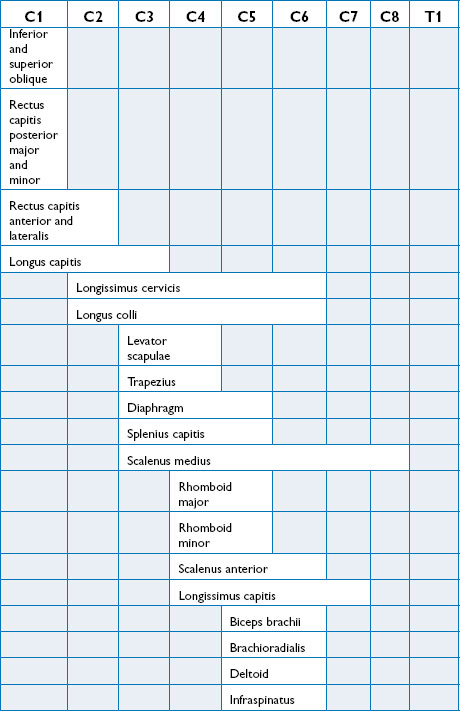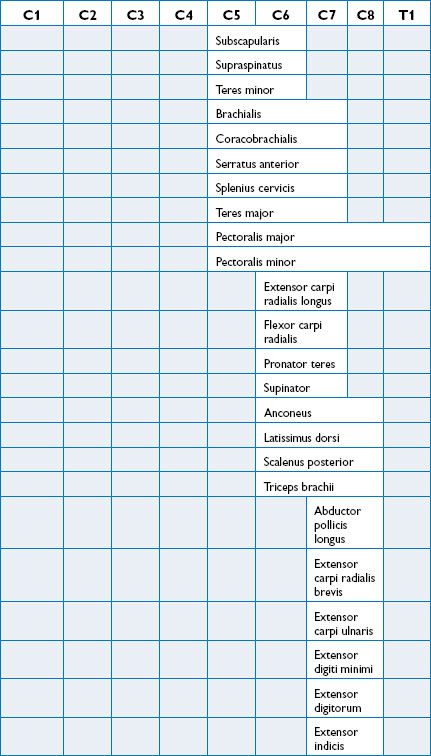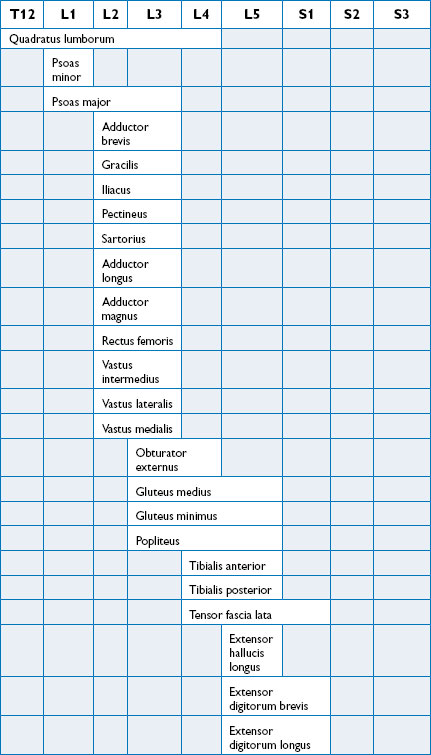SECTION 2 Musculoskeletal
Muscles listed by function
Head and neck
Flexors: longus colli, longus capitis, rectus capitis anterior, sternocleidomastoid, scalenus anterior
Lateral flexors: erector spinae, rectus capitis lateralis, scalenes (anterior, medius and posterior), splenius cervicis, splenius capitis, trapezius, levator scapulae, sternocleidomastoid
Extensors: levator scapulae, splenius cervicis, trapezius, splenius capitis, semispinalis, superior oblique, sternocleidomastoid, erector spinae, rectus capitis posterior major, rectus capitis posterior minor
Trunk
Lateral flexors: quadratus lumborum, intertransversarii, external oblique, internal oblique, erector spinae, multifidus
Shoulder
Extensors: latissimus dorsi, teres major, pectoralis major, deltoid (posterior fibres), triceps (long head)
Medial rotators: subscapularis, teres major, latissimus dorsi, pectoralis major, deltoid (anterior fibres)
Wrist
Flexors: flexor carpi ulnaris, flexor carpi radialis, palmaris longus, flexor digitorum superficialis, flexor digitorum profundus, flexor pollicis longus
Extensors: extensor carpi radialis longus, extensor carpi radialis brevis, extensor carpi ulnaris, extensor digitorum, extensor indicis, extensor digiti minimi, extensor pollicis longus, extensor pollicis brevis
Fingers
Flexors: flexor digitorum superficialis, flexor digitorum profundus, lumbricals, flexor digiti minimi brevis
Hip
Abductors: gluteus maximus, gluteus medius, gluteus minimus, tensor fascia lata, sartorius, piriformis
Knee
Flexors: semitendinosus, semimembranosus, biceps femoris, gastrocnemius, gracilis, sartorius, plantaris, popliteus
Extensors: rectus femoris, vastus lateralis, vastus intermedius, vastus medialis, tensor fascia lata
Ankle
Plantarflexors: gastrocnemius, soleus, plantaris, peroneus longus, tibialis posterior, flexor digitorum longus, flexor hallucis longus, peroneus brevis
Dorsiflexors: tibialis anterior, extensor digitorum longus, extensor hallucis longus, peroneus tertius
Toes
Flexors: flexor digitorum longus, flexor digitorum accessorius, flexor digitorum brevis, flexor hallucis longus, flexor hallucis brevis, flexor digiti minimi brevis, interossei, lumbricals, abductor hallucis
Extensors: extensor hallucis longus, extensor digitorum longus, extensor digitorum brevis, lumbricals, interossei
Alphabetical listing of muscles
Abductor pollicis longus
Origin: upper part of posterior surface of ulna, middle third of posterior surface of radius, interosseous membrane
Adductor hallucis
Origin: oblique head – bases of second to fourth metatarsal, sheath of peroneus longus tendon; transverse head – plantar metatarsophalangeal ligaments of lateral three toes
Adductor magnus
Origin: inferior ramus of pubis, conjoined ischial ramus, inferolateral aspect of ischial tuberosity
Adductor pollicis
Origin: oblique head – palmar ligaments of carpus, flexor carpi radialis tendon, base of second to fourth metacarpals, capitate; transverse head – palmar surface of third metacarpal
Biceps brachii
Origin: long head – supraglenoid tubercle of scapula and glenoid labrum; short head – apex of coracoid process
Insertion: posterior part of radial tuberosity, bicipital aponeurosis into deep fascia over common flexor origin
Biceps femoris
Origin: long head – ischial tuberosity, sacrotuberous ligament; short head – lower half of lateral lip of linea aspera, lateral supracondylar line of femur, lateral intermuscular septum
Deltoid
Action: anterior fibres – flex and medially rotate shoulder; middle fibres – abduct shoulder; posterior fibres – extend and laterally rotate shoulder
Origin: anterior fibres – anterior border of lateral third of clavicle; middle fibres – lateral margin of acromion pro-cess; posterior fibres – lower edge of crest of spine of scapula
Diaphragm
Action: draws central tendon inferiorly. Changes volume and pressure of thoracic and abdominal cavities
Origin: posterior surface of xiphoid process, lower six costal cartilages and adjoining ribs on each side, medial and lateral arcuate ligaments, anterolateral aspect of bodies of lumbar vertebrae
Dorsal interossei (foot)
Insertion: bases of proximal phalanges and dorsal digital expansion (first attaches medially to second toe; second, third and fourth attach laterally to second, third and fourth toes, respectively)
Dorsal interossei (hand)
Action: abducts index, middle and ring fingers, flexes metacarpophalangeal joints and extends interphalangeal joints
Insertion: bases of proximal phalanges and dorsal digital expansions (first attaches laterally to index finger; second and third attach to both sides of middle finger; fourth attaches medially to ring finger)
Extensor digitorum brevis
Origin: superolateral surface of calcaneus, inferior extensor retinaculum, interosseous talocalcaneal ligament
Insertion: base of proximal phalanx of great toe, lateral side of dorsal hood of adjacent three toes
Extensor digitorum longus
Origin: upper three-quarters of medial surface of fibula, interosseous membrane, lateral tibial condyle
External oblique
Insertion: outer lip of anterior two-thirds of iliac crest, abdominal aponeurosis to linea alba stretching from xiphoid pro-cess to symphysis pubis
Flexor carpi ulnaris
Origin: humeral head – medial epicondyle via common flexor tendon; ulnar head – medial border of olecranon and upper two-thirds of border of ulna
Flexor digitorum accessorius
Origin: medial head – medial tubercle of calcaneus; lateral head – lateral tubercle of calcaneus and long plantar ligament
Flexor digitorum brevis
Insertion: tendons divide and attach to both sides of base of middle phalanges of second to fifth toes
Flexor digitorum profundus
Origin: medial side of coronoid process of ulna, upper three-quarters of anterior and medial surfaces of ulna, interosseous membrane
Flexor digitorum superficialis
Origin: humeroulnar head – medial epicondyle via common flexor tendon, medial part of coronoid process of ulna, ulnar collateral ligament, intermuscular septa; radial head – upper two-thirds of anterior border of radius
Insertion: tendons divide and insert into sides of shaft of middle phalanx of second to fifth digits
Flexor hallucis longus
Origin: lower two-thirds of posterior surface of fibula, interosseous membrane, intermuscular septum
Gastrocnemius
Origin: medial head – posterior part of medial femoral condyle; lateral head – lateral surface of lateral femoral condyle
Gluteus maximus
Origin: posterior gluteal line of ilium, posterior border of ilium and adjacent part of iliac crest, aponeurosis of erector spinae, posterior aspect of sacrum, side of coccyx, sacrotuberous ligament, gluteal aponeurosis
Iliacus
Origin: superior two-thirds of iliac fossa, inner lip of iliac crest, ala of sacrum, anterior sacroiliac and iliolumbar ligaments
Iliocostalis lumborum
Origin: medial and lateral sacral crests, spines of T11, T12 and lumbar vertebrae and their supraspinous ligaments, medial part of iliac crest
Infraspinatus
Insertion: middle facet on greater tubercle of humerus, posterior aspect of capsule of shoulder joint
Internal oblique
Origin: lateral two-thirds of inguinal ligament, anterior two-thirds of intermediate line of iliac crest, thoracolumbar fascia
Insertion: lower four ribs and their cartilages, crest of pubis, abdominal aponeurosis to linea alba
Interspinales
Origin and insertion: extend between adjacent spinous processes (best developed in cervical and lumbar regions – sometimes absent in thoracic)
Latissimus dorsi
Origin: spinous processes of lower six thoracic and all lumbar and sacral vertebrae, intervening supra- and interspinous ligaments, outer lip of iliac crest, outer surfaces of lower three or four ribs, inferior angle of scapula
Longus colli
Origin: inferior oblique part – front of bodies of T1–T2/3; vertical intermediate part – front of bodies of T1–T3 and C5–C7; superior oblique part – anterior tubercles of transverse processes of C3–C5
Insertion: inferior oblique part – anterior tubercles of transverse processes of C5 and C6; vertical intermediate part – front of bodies of C2–C4; superior oblique part – anterior tubercle of atlas
Multifidus
Origin: back of sacrum, aponeurosis of erector spinae, posterior superior iliac spine, dorsal sacroiliac ligaments, mamillary processes in lumbar region, all thoracic transverse processes, articular processes of lower four cervical vertebrae
Insertion: spines of all vertebrae from L5 to axis (deep layer attaches to vertebrae above; middle layer attaches to second or third vertebrae above; outer layer attaches to third or fourth vertebrae above)
Pectoralis major
Origin: clavicular attachment – sternal half of anterior surface of clavicle; sternocostal attachment – anterior surface of manubrium, body of sternum, upper six costal cartilages, sixth rib, aponeurosis of external oblique muscle
Piriformis
Origin: front of second to fourth sacral segments, gluteal surface of ilium, pelvic surface of sacrotuberous ligament
Pronator teres
Origin: humeral head – medial epicondyle via common flexor tendon, intermuscular septum, antebrachial fascia; ulnar head – medial part of coronoid process
Psoas major
Origin: bodies of T12 and all lumbar vertebrae, bases of transverse processes of all lumbar vertebrae, lumbar intervertebral discs
Quadratus lumborum
Action: laterally flexes trunk, extends lumbar vertebrae, steadies twelfth rib during deep inspiration
Rectus femoris
Origin: straight head – anterior inferior iliac spine; reflected head – area above acetabulum, capsule of hip joint












